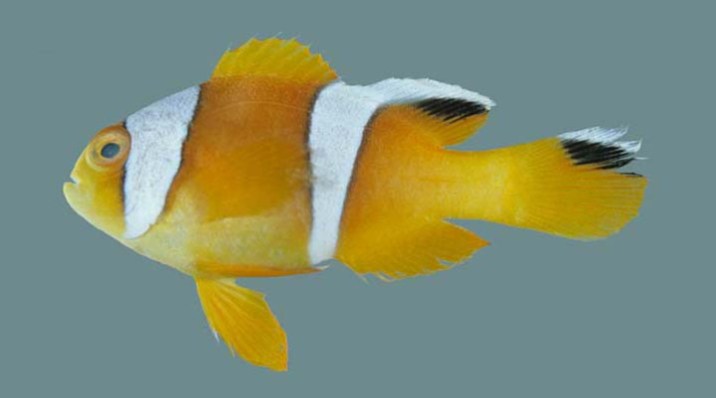Common Name: Chagos Clark’s Anemonefish
Scientific Name: Amphiprion cf clarkii
Distribution: Chagos Archipelago
Type Locality: n/a
Identification: Body and fins bright yellow-orange, never melanistic. Stripes relatively thick. Posterior stripe entirely hidden. Juvenile with white margin in the posterior dorsal fin; caudal fin white marginally, black submarginally.
Similar: Superficially similar to the true Chagos Anemonefish (A. chagosensis), a member of the perideraion group of “Skunk Clownfishes” that frequent the Magnificent Sea Anemone (Heteractis magnifica). The coloration of this fish is typically duller, sometimes quite dark and brown, with darker ventral fins and considerably thinner stripes. Juveniles also differ, lacking the white fin patterning. The Chagos A. cf clarkii has also been confused with the Red Sea endemic A. bicinctus on account of their similar patterning, but this makes little sense biogeographically, as no other Red Sea species occurs this far east, and the two do differ in other subtle ways, such as their stripe shape and coloration.
Notes: While it is probably common within its range, this unique fish warrants recognition as an endangered species. Known from a variety of host anemones, including Condylactis doreensis, Stichodactyla mertensii, Heteractis magnifica and Entacmaea quadricolor. This idiosyncratic member of the clarkii group has consistently been misidentified and conflated with the true Chagos Anemonefish. Given its bright colors and rarity, this would be an attractive fish for aquarium breeders. With a range seemingly restricted to the protected Chagos Archipelago, the only chance this fish has of ever entering an aquarium is through the cooperation of conservationists and mariculturists.
The unusual traits of this fish—the bright colors and complete absence of melanism—and its general similarity to A. chagosensis hint at a possibility of hybrid speciation. The only other entirely amelanistic population occurs on the Great Barrier Reed, which, not coincidentally, has also been historically confused with a similar sympatric species that it likely has hybridized with. There’s a great evolutionary puzzle waiting to be solved here.















